Walk and Drive Through Towering Redwoods
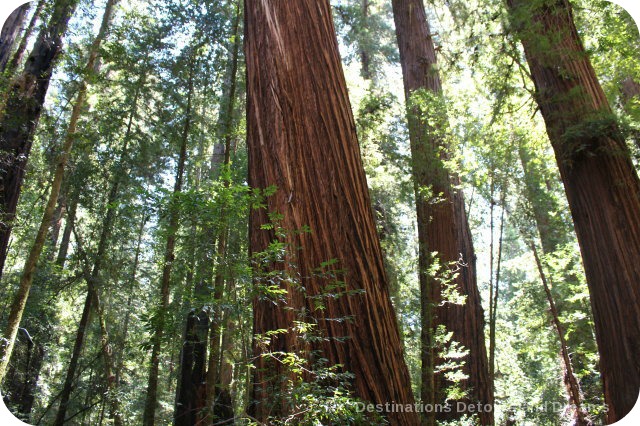
Experiencing California’s giant redwood trees two ways:
walking in Hendy Woods State Park and driving the Avenue of the Giants
A trip through northern California would not be complete without seeing the towering redwood forests. I was able to experience the redwoods in two ways. The first was a guided walk in Hendy Woods State Park. I learned much from our enthusiastic guide. The second was a drive along Avenue of the Giants.
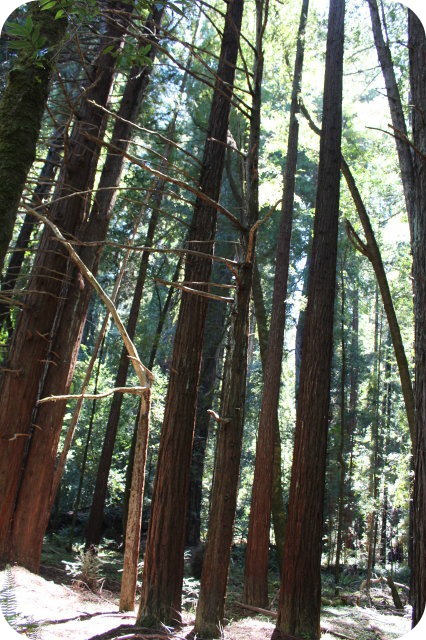
Redwoods get their name from the reddish-brown colour of their bark and heartwood, a colour caused by high tannin levels. There are actually two species of California redwoods.
The Coast Redwood (Sqeuoia sempervirens) is the world’s tallest tree. The tallest of these exceed 350 feet. Their trunks have a diameter of 12 to 20 feet and they can live for over 2,000 years. They grow in moist, coastal areas of the western United States from as far south as Big Sur, California to as far north as southern Oregon.
The Giant Sequoia (Sequoiadendron giganteum) is known as the world’s most massive tree, not because of its height or breadth (although those are impressive), but because of its heaviness. They can reach a height of over 250 feet and live for more than 3,000 years. The Giant Sequoia grow in the Sierra Nevadas.
There is a third type of redwood, the Dawn Redwood, which is native to China. It is different than the other two in that its leaves turn colour in autumn and fall off. For some time, it was thought the Dawn Redwood was extinct until a small grove was discovered in a remote area of China in 1944.
All three redwoods are descendants of a group of conifers which existed more than 144 million years ago in the age of the dinosaurs.
Hendy Woods State Park
Hendy Woods State Park is located in the middle of the Anderson Valley wine district, less than three hours from San Francisco. Located inland, the park is warmer and less foggy than redwood forests directly along the coast.
The park is named after Joshua P. Hendy, who came to California from England in 1849. His first venture was a redwood lumber mill. In 1856, he founded Joshua Hendy Iron Works to manufacture mining equipment. Joshua grew to love his home in the Anderson Valley and the redwood groves. He vowed the trees on his property would not be chopped down or harmed. Redwood forests in the area were being rapidly depleted because of heavy demand for redwood in construction.
The trees were not harmed while Hendy was alive. After his death, large redwood stands surrounding Hendy’s groves were logged, but Big Hendy and Little Hendy groves were spared. Hendy Woods was sold to the people of California in 1958.
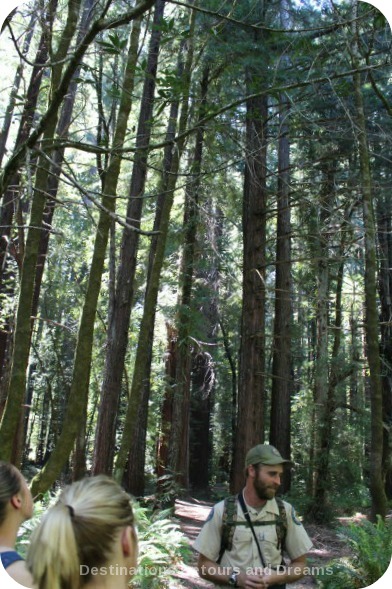
In one of those wonderful moments of synchronicity which sometimes happens when travelling, we arrived at Hendy Woods just as a ranger was beginning a tour through the grove. As we walked through trees, the ranger, who lived year round in a cabin in the park, educated us about redwoods. The trees themselves provided the illustrations for his lecture.
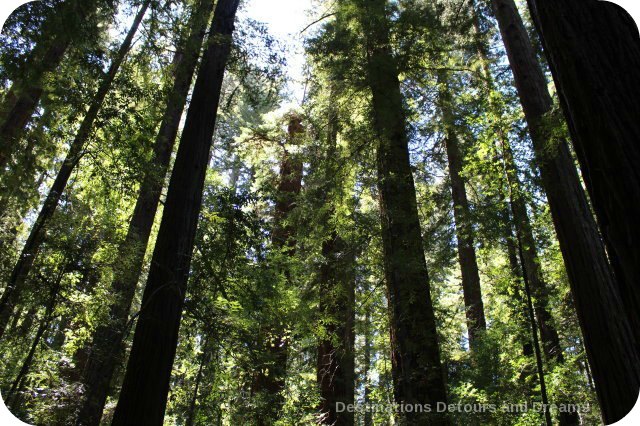
It is hard for water from the root system of a very tall tree to be circulated all the way to the top. Redwoods have a second way of obtaining moisture. Needles at the top of the tree absorb moisture directly from fog condensation.
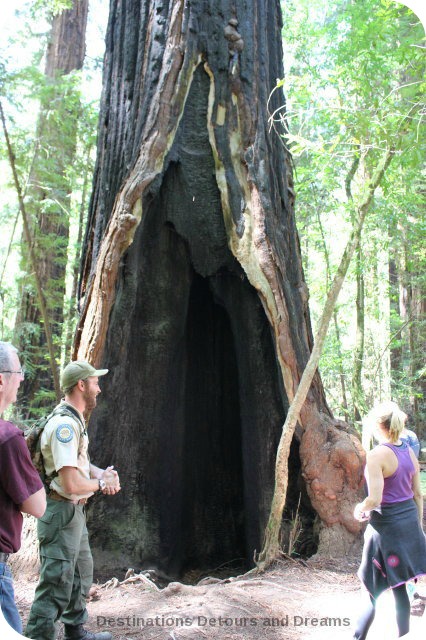
Hot fires may kill young redwoods, but once redwoods are mature they are extremely resistance to fire. The bark is very thick, as much as one foot in places. When exposed to fire, it chars into a heat shield. The bark also contains chemicals which are poisonous or distasteful to normal tree pests such as termites and ants.
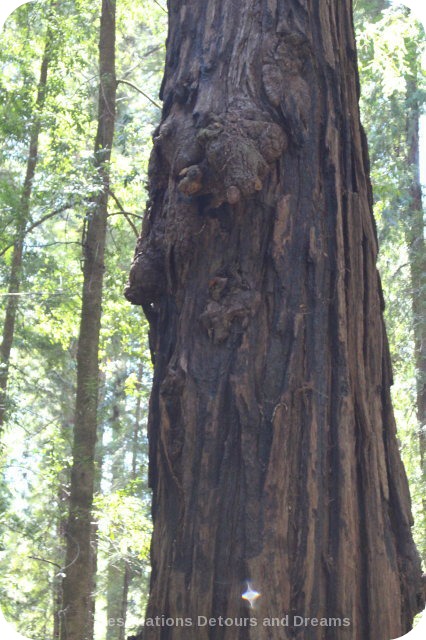
Redwoods grow burls on their trunk in response to wounds or stress. The burls cover the wound and protect it. Another type of burl produces new shoots and roots on trees when the life of the tree is threatened. The grain of the wood on the burls is usually twisted, contorted and deformed, making for interesting designs in furniture and woodwork. Burls are sought after because of that, but removing the burls from the tree damages and weakens the tree.
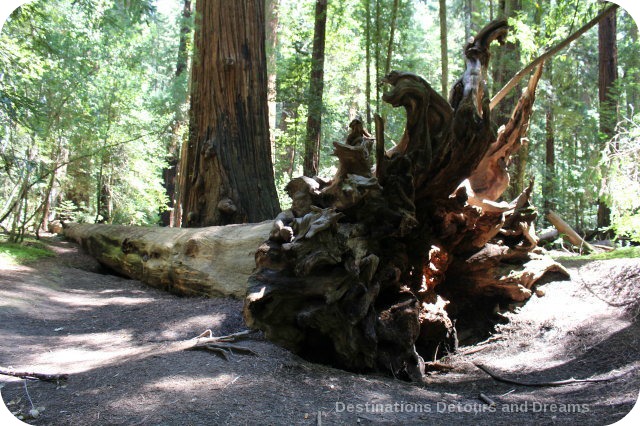
Redwoods have a shallow root system. Instead of going deep, they spread out horizontally not far below ground and intertwine with roots of other redwoods. The intertwining helps support the tall trees.
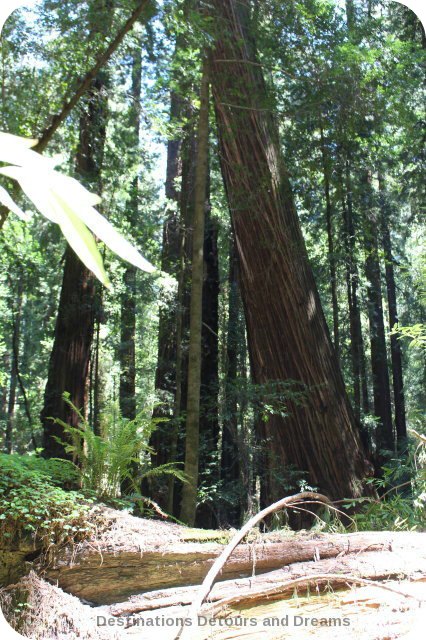
would this leaning tree still be standing?
The ranger told us about widow-makers. Redwoods are susceptible to wind. Pieces can break off the top. The pieces are heavy and fall to the ground with some degree of velocity (it is a long way in some cases). The piece of wood can easily kill a man in its path. If it gets too windy in the park (most likely to happen in later afternoon), guided tours are cancelled.
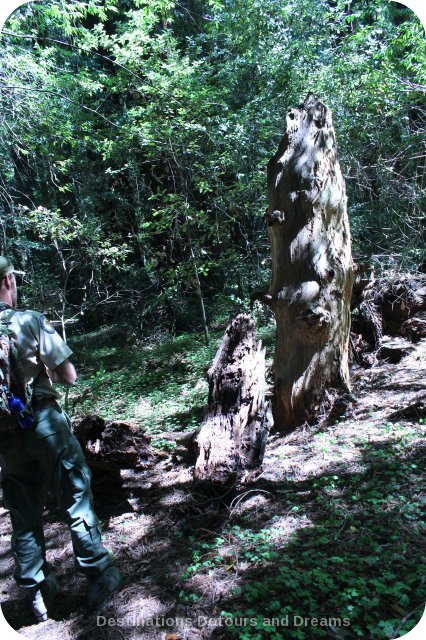
When I first walked into the grove, I felt as if I’d entered another, almost mystical, world. The tall trees and insulating ground cover created a protected and private space. It was very quiet. The ranger said there was little wildlife. There were a few birds high in the trees, but they too were silent. I understood why some people consider redwood forests sacred spaces.
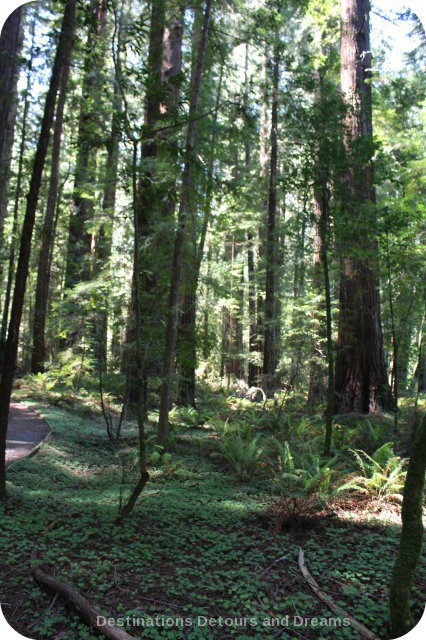
Hendy Woods State Park is located eight miles north of Boonville, California, a half-mile south of Highway 128 on Philo-Greenwood Road in Mendocino County.
Avenue of the Giants
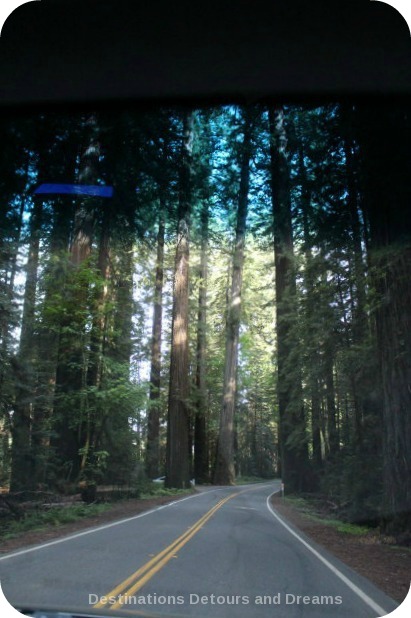
Avenue of the Giants is a scenic 31-mile drive along old Highway 101, which runs parallel to Freeway 101. It claims to be the most outstanding display of giant redwoods trees. Humboldt Redwoods State Park, which encompasses over 53,000 acres and 140 memorial groves, surrounds the drive.
Humboldt Redwoods State Park exists today largely because of a 1917 road trip by three scientists. They were disturbed by the over-logging of the ancient trees and formed the Save the Redwoods League in 1918. Humboldt County women formed a local chapter in 1919 and in 1926 John D. Rockefeller donated $1,000,000 to purchase the groves at Dyerville Flats.
The drive, with towering redwoods on either side, is impressive. We spotted a couple of trees along the road which bore marks of trees brushing up too close. There are a number of spots one can stop along the drive and hike or picnic. The park has fishing and camping. There are also lodges and inns along the route. And a few slightly cheesy tourist attractions.
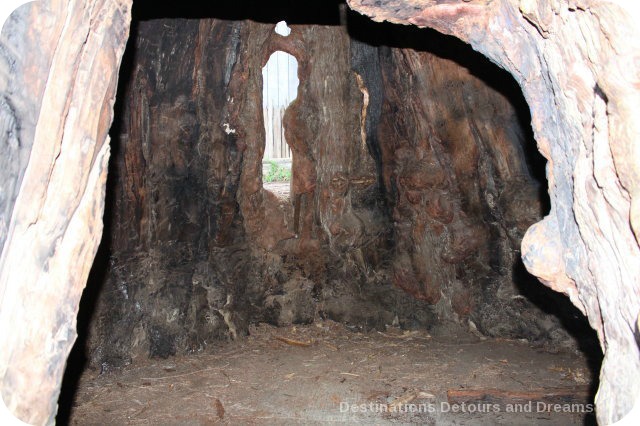
The Chimney Tree was created by a fire burning out its centre in 1914. The diameter of the room is 12.6 feet. The circumference of the tree is 50 feet, 4 inches.
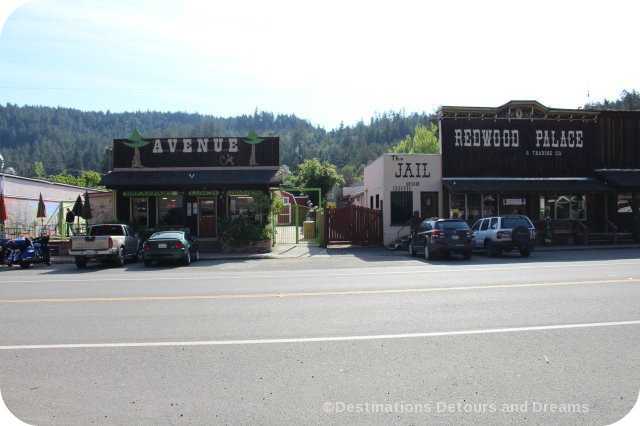
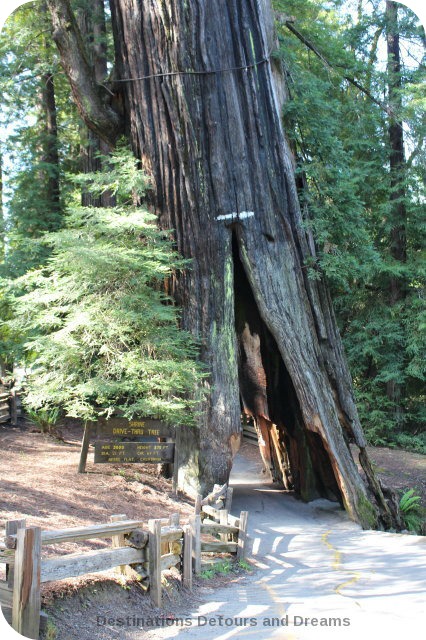
You can drive your car through an opening in a living redwood tree for a fee. The spot at Myers Flat also has a log you can drive on and two-story treehouses for children to play in.
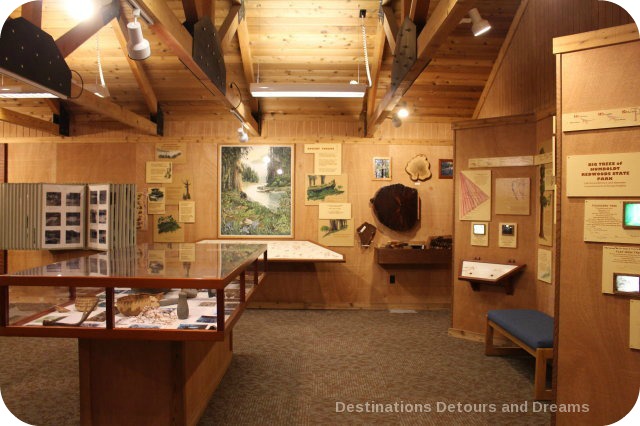
The Humboldt Redwoods State Park Visitor Center is located along the Avenue and well worth stopping at. In addition to a variety of park information and gift items, there is a free museum. The displays highlight information about the redwoods and history of the park. Samples of all three types of redwood are planted in front. Also in front is a section of tree which fell near Bear Creek in 2006. Date tags indicate the age of the tree by comparing points to events in history. The beginning ring at the centre dates from 912 A.D.
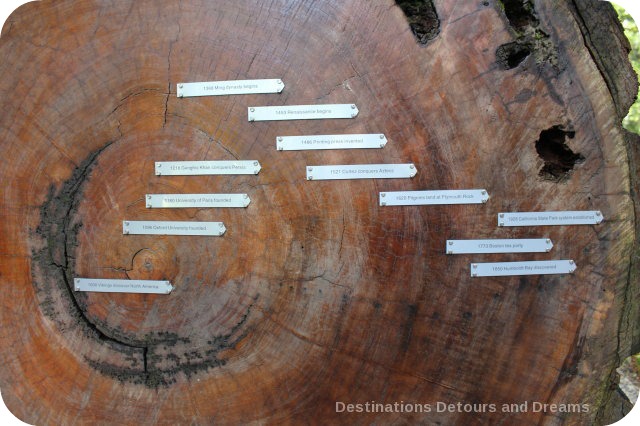
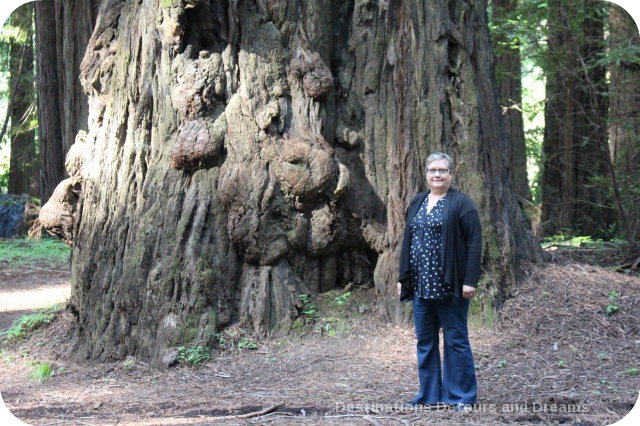
The south end of Avenue of the Giants is just north of Gaberville. The exit from the Freeway 101 is well marked. The north end rejoins the freeway just south of Scotia.
Other places to see redwoods in California include Redwood National Park, Calaveras Big Trees State Park, Muir Woods National Monument, Big Basin Redwoods State Park, Mariposa Grove in Yosemite National Park, Sequoia National Park, Julia Pfeiffer Burns State Park, Limekiln State Park and Pfeiffer Sur State Park.
Destinations Detours and Dreams monthly e-newsletter contains behind the scenes information, sneak peeks ahead, travel story recaps and more. SIGN UP HERE
PIN IT
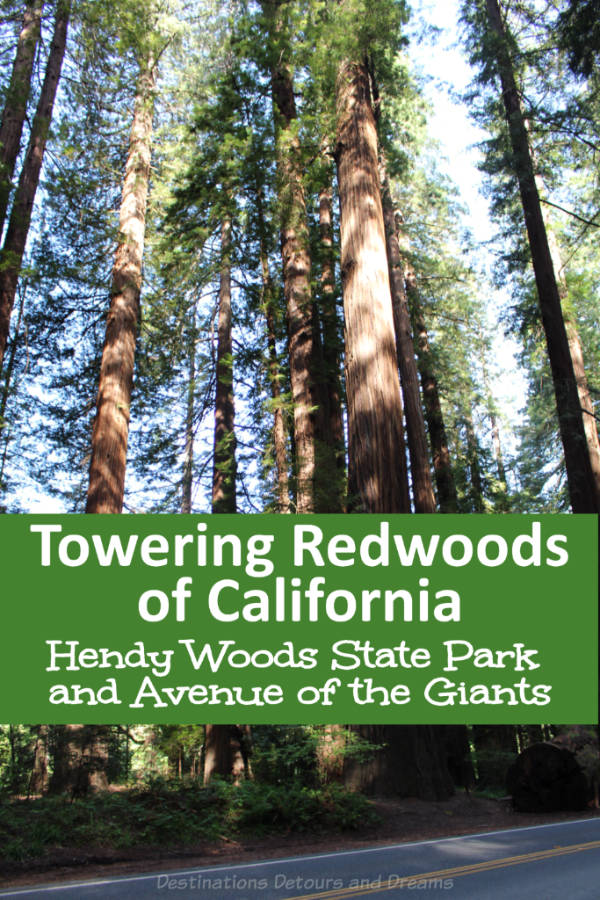

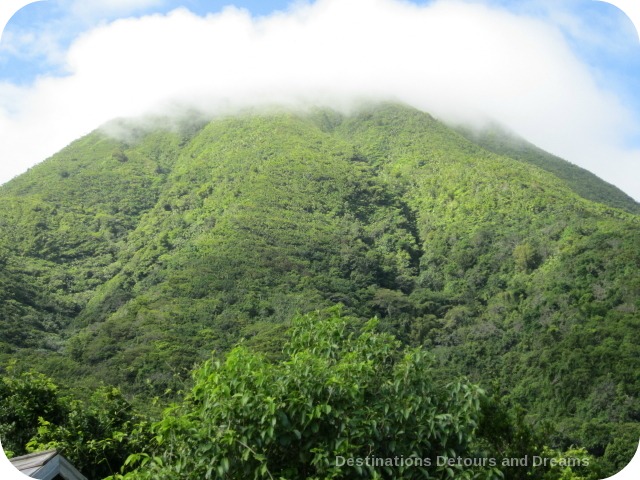
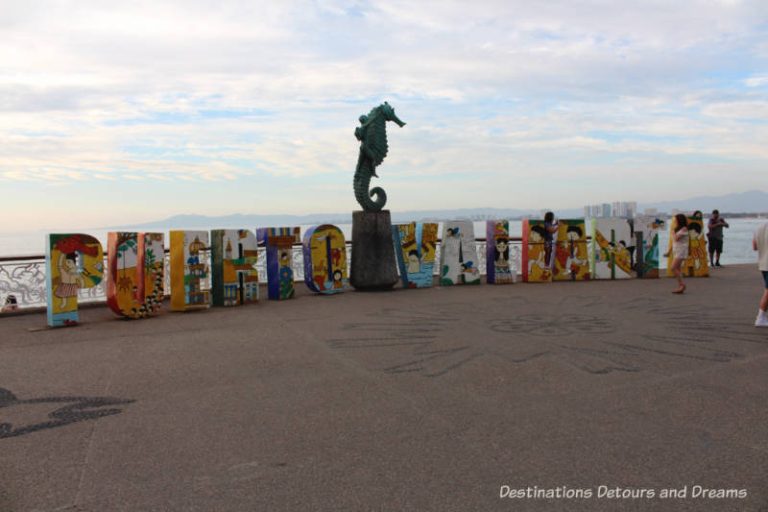
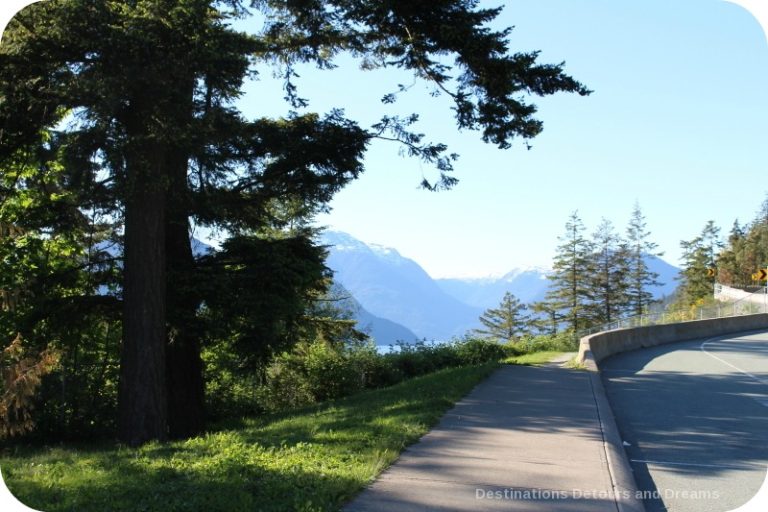
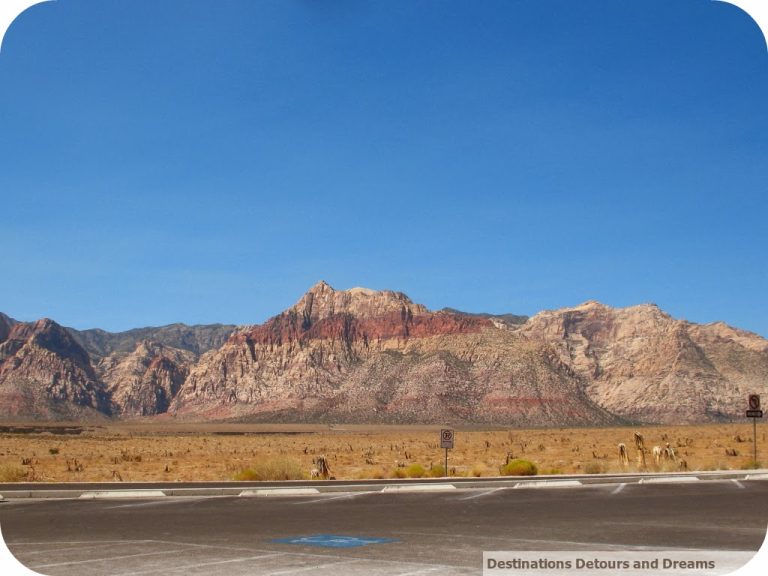
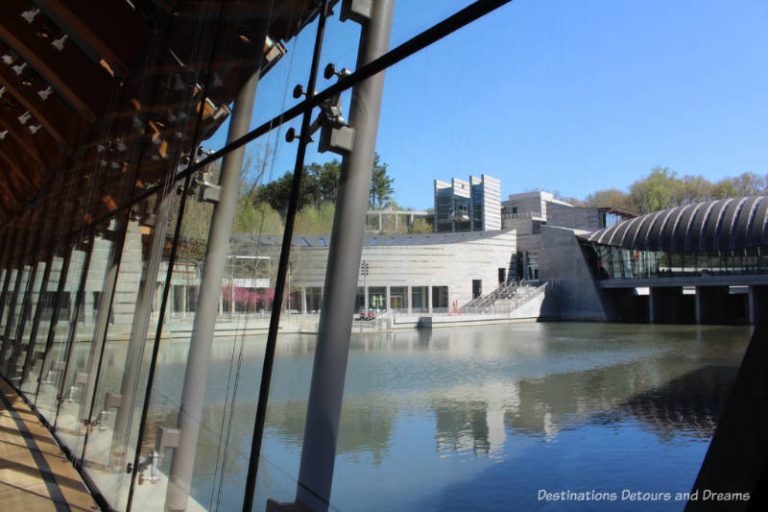
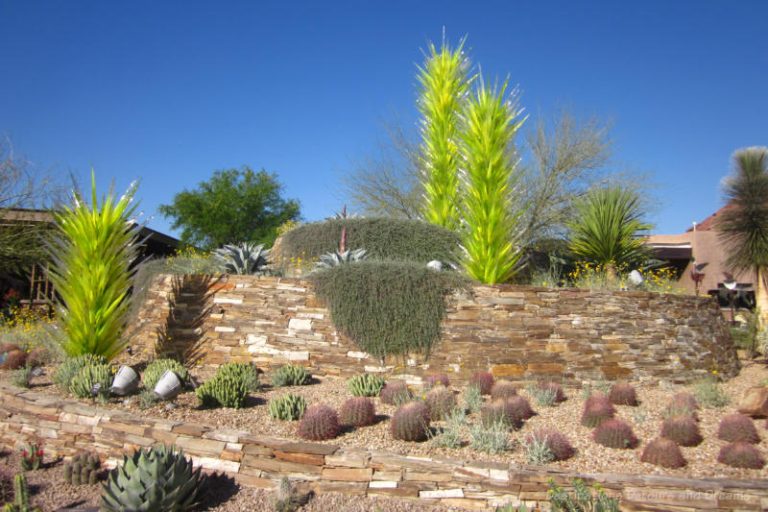
Oh my! It does look positively mystical! Great tour and thank you!
Jacquie, mystical and magestic.
I just love these redwood trees. It is so tranquil in the state Park I hate to leave. Another one I enjoy a lot is Muir Woods. Not in same league, but beautiful nonetheless and not so far off the beaten path.
Susan, I agree it was tranquil. I will have to check out Muir Woods next time I’m in the area.
Beautiful scenery, we drove through that tree once many years ago (No fee, lol) but we are planning on doing this trip in February and will for sure check these places out. Good information. Thanks
Carol, we stopped to look at the Shine-Thru tree, but didn’t actually drive through it. Enjoy your February trip – there is so much to see and do in California!
I’ve been to the Redwoods twice and the Sequoias once. One can certainly get neck strain from spending so much time looking up. I’m sure I’ll return to them again in the future as well. I never did come across the tree that can be driven through though.
Jeri, it is a long way to look up. The trees are impressive in so many ways.
The trees look overwhelmingly tall. Thank goodness you had a tour guide otherwise you would not be able to see the wood for the trees (pun intended!)
I have not been to a forest for some years – I obviously need to get out more!
As a child we had school residential trips where we visited forests and participated in fun activities. On one occasion we had a sledge – fun times!
Phoenicia, the trees are incredibly tall! There is something rejuvenating about time in the woods. I had to look up what you meant by sledge – I think we’d call that a sleigh ride on this side of the pond.
The redwood trees are beautiful. Still remember them from when I was 19 and visited.
Catarina, the redwoods are definitely memorable.
Sorry to say I never went to see the redwoods when we were in California. But we did see a on at the Cleveland botanical gardens last summer. Wow, they are impressive. I have to go here the next time I go to California.
Sabrina, you should see the redwood next time you’re in California – very impressive to see and be in an entire forest of them.
Thanks for sharing! Looks to mystical.I loved the ‘Shine Drive Through Tree’.
Sushmita, mystical is a good description.
Great post, Donna. I love driving up the West Coast, for the California Redwoods and for the Douglas Fir Trees in BC. Equally impressive and beautiful. We drove thru Cathedral Park on Vancouver Island earlier this year and it reminded me how much I love these towering giants.
Doreen, it’s been years since I drove through Cathedral Park but I remember it as being very impressive.
This brings back such wonderful memories Donna! It’s been decades since I’ve been in that part of the country, but you never forget how spectacular it is. Living in Oregon now I am surrounded by towering pine trees and everyday when I take my dog on one of the hiking trails around our home I marvel at how tall they are because there’s nothing like them in Maui where I’ve lived most of my life. Brilliant!
Marquita, We don’t have trees that tall on the prairies either – they are certainly something to marvel at.
Donna, thanks for the journey. Your photos with the people in them showed how impressive and large the trees are. I think the walk through the redwoods would be almost like a healing balm. The chimney tree and the drive-through tree are amazing. What a glorious time you must have had. Thanks for sharing.
Lenie, I like describing a walk through the redwoods as a healing balm. It would nice to live close enough to make that walk a regular part of one’s life.
One of my dreams is to go there and see the redwoods. It is amazing something that live that long. It is kind of scary to think you can be killed by a piece of limb falling down on a windy day.
Thanks for sharing with us.
William, it is amazing how long the redwoods live. I didn’t know the bit about the dangers of the falling limbs until the ranger told us – it is scary. I think I’d stay out of the redwood forests in times of high wind.
I love these trees. When I lived in southern California, I used to go camping in King’s Canyon & Sequoia National Park. The trees never failed to astound me. Thirty years later and if I shut my eyes and take a deep breath, I can smell the trees, the ground underfoot.
Rose Mary, there are outstanding!
I’ve never made that trip. Must be awe inspiring. Nice job capturing it in images.
Thanks Ken. The images give a sense of the forest but I don’t think they fully capture the magnitude or the feeling of being in them. It is awe inspiring.
I’ve never seen Redwoods but they really are beautiful. I love that you can actually drive through one.That is interesting that they eventually grow resistance to fire. I’m sure I will get to Northern California someday to see them – definitely on my list.
Erica, I learned a lot of interesting things about the redwoods and how they survive from the ranger on our guided walk. The resistance to fire was one. The way their root systems interconnect was another.
The part of California that runs northward from San Francisco to the Oregon border is a quiet, largely undiscovered part of America, and it’s good that you’ve gotten up there in your quest to see the redwoods. (I myself am a native Californian – I was born and raised there, and I live there now – but Davis is as far north as I’ve been.) Time and money permitting, I encourage you to further explore the upper reaches of California and keep us posted on what you see.
Andy, this was my first trip to central and north California. It was great. I’m not sure when I’ll get back to explore more – but there is certainly lots more to explore if I do get back.